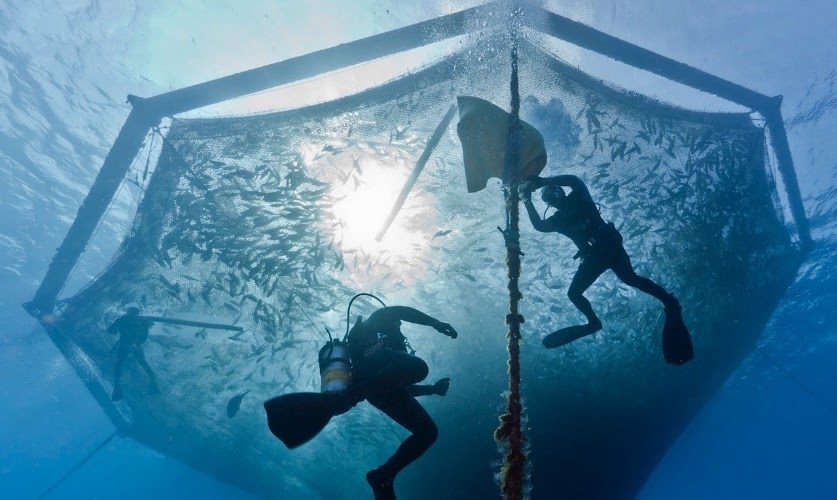The increasing demand for American-grown seafood and improved technology to farm in the open ocean provides an opportunity for domestic aquaculture expansion, increased protein production, reduced social conflict, and lower exposure to land-based sources of pollution. Consumer pressure on the aquaculture industry to adopt sustainable practices has improved technology, coastal management, and responsible offshore development through innovative spatial modeling techniques. With growing interest in offshore aquaculture in Florida, NCCOS teamed with the Florida Department of Agriculture and Consumer Services (FDACS) Division of Aquaculture to develop a spatial planning analysis for a “first look” at areas that may hold potential for aquaculture operations in offshore state waters along Florida’s Gulf coast.
Why We Care
-
- The aquaculture industry, in tandem with the adoption of advanced aquaculture and planning techniques, has begun to realize that a large amount of untapped potential lies in some state waters and the U.S. Exclusive Economic Zone (EEZ).
- Currently, imports account for 70–85% of the seafood consumed in the U.S., more than half of which are produced from aquaculture in other countries, resulting in a $17 billion seafood trade deficit in 2020. The United States ranks 18th in the world in aquaculture production.
- Expanding U.S. offshore aquaculture operations would alleviate some of this seafood trade deficit, contribute to domestic food supply chains, strengthen domestic food security, and supply direct and indirect jobs in working waterfront communities. Aquaculture also has the potential to enhance or restore ecosystem services, habitat, and biodiversity in marine ecosystems; mitigate the impacts of climate change; provision food for a growing global population; contribute to fisheries management objectives; and contribute to emerging technologies and novel markets like biofuels and bioplastics.

Divers maintain an open water net pen below the surface. The monitoring of finfish grown within the natural environment ensures the health of the fish and of the surrounding ecosystem. Credit: NOAA Sea Grant.
What We Did
With growing interest in offshore aquaculture, both in Florida and throughout the U.S., FDACS initiated a partnership with NCCOS in 2019 to investigate coastal ocean areas in state waters along Florida’s Gulf coast that may be suitable for offshore aquaculture development. Marine spatial planning efforts included a suitability analysis followed by precision siting to ensure that potential impacts to sensitive species and habitats, as well as other marine industries, would be minimized.
These “first look” siting options will allow FDACS to work collaboratively with other state and federal agencies, the aquaculture industry, and other stakeholders to find the best options for offshore aquaculture in Florida.
What We Found
Through a rigorous site suitability analysis, 34 total Potential Offshore Aquaculture Zone (POAZ) options (ranging in size from 204 to 7,407 acres, and totaling 54,904 acres) were identified within the Area of Interest (the study area between Pensacola and Sarasota, FL). The POAZs were grouped around Pensacola, Apalachicola, St. Petersburg, and Sarasota. These final zones represent 1% of the total 4.3 million acre Area of Interest.
The ability to site offshore aquaculture in Florida state waters of the Gulf of Mexico will require additional input from and collaboration among various stakeholders, state and federal entities, and interest groups to determine which types of aquaculture (e.g., finfish, shellfish, macroalgae) might be suitable; understanding social perceptions of offshore aquaculture; and understanding socioeconomic factors that could support development of aquaculture in regions where POAZs were identified.
Benefits of Our Work
-
- By providing this analysis, this report helps remove one of the major barriers to entry for many potential producers — having access to high quality spatial data and the ability to analyze those data to find a suitable location for a farm offshore.
- This work is complementary to initiatives led by FDACS to further identify growth sectors and opportunities that align with industry needs and the needs of a broad range of ocean users.
- The results of this spatial analysis and additional information collected from stakeholder engagement will provide important feedback for strategic planning for aquaculture development in Florida state waters. This analysis and planning process will increase regulatory confidence in aquaculture operations and aims to reduce user conflict while increasing sustainability, economic viability, and responsible farming.
Next Steps
-
- This report offers a starting point to assess the potential for offshore aquaculture development in Florida. Future efforts will reduce data gaps, test statistical assumptions of the analysis, and refine results.
- Feedback from and collaboration with multiple local stakeholders (for example, through focus groups and workshops) will be crucial next steps before any regulatory or permitting steps move forward. The FDACS Division of Aquaculture will conduct deliberate and collaborative stakeholder engagement in order to refine the results in this report and make a fully informed decision, along with state and federal partners, about potential placement of offshore aquaculture production facilities in Florida Gulf state waters.
- FDACS will partner with state agencies investigating and mapping resources in state waters that overlap with areas identified through this spatial planning project.
